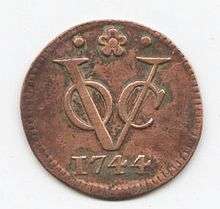Dutch East India Company coinage
The Dutch East India Company (Dutch: Vereenigde Oostindische Compagnie, often known as VOC) was a chartered company which issued a considerable series of coinage in bronze, silver and gold for its territories in the Far East between 1602 and 1799.
Background
The Dutch East India Company (VOC) was established as a chartered company in 1602 and was designed to replace a number of earlier Dutch trading companies.[1] To prevent the constant infighting between rival companies, the Dutch States-General gave the company officially recognised status and allowed it fulfill some function usually reserved for a state. The company's charter allowed it to have its own military forces, make treaties and coin its own money.[1] It was given full powers to act between the Cape of Good Hope and the Straits of Magellan.[1] The company grew rapidly, founding towns and colonies at Cape Town, Batavia (modern Jakarta) and elsewhere.[1]
Coins
During the 200 years of its existence, VOC issued large quantities and many different patterns of coins.[2] Writers on the subject distinguish between the types produced in the Netherlands for the company and those issued by it locally in Asia.[2] Both types often circulated together, but European coins were more common in some areas than others.[2] Most coins issued for the company carried its distinctive monogram of the interlocked letters "VOC".[3] The most common denominations were the Guilder, Ducatoon, Stiver (or Stuiver) and Doit (Duit). Some fractions, like the Half-Doit, were also produced.
Coins were issued in the Netherlands during the mid-17th century and again from 1744 until its dissolution.[2] Coins were struck in gold, silver, bronze and, unusually, pewter.[2] They were issued by the local mints of the Netherlands, including Holland, Utrecht, Zeeland, Gelderland and Overijssel.[4]
The locally produced coins in Asia display more variation and were produced in gold, silver and bronze.[3] Countermarks are sometimes seen on these coins, either stamped by the company or by local private individuals.[5] Foreign coins, including Japanese Koban or Surat rupees, were sometimes countermarked by the company for its own use.[6]
See also
References
- 1 2 3 4 Bucknill 1931, p. 15.
- 1 2 3 4 5 Bucknill 1931, p. 16.
- 1 2 Bucknill 1931, pp. 16-7.
- ↑ Dniewcollectors.
- ↑ Bucknill 1931, p. 17.
- ↑ Bucknill 1931, pp. 19-21.
Bibliography
- Bucknill, John A. S. (1931). The Coins of the Dutch East Indies: An Introduction to the Study of the Series. Asian Educational Services. ISBN 8120614488.
- "Dutch East India Company Coins". dniewcollectors.blogspot.co.uk. Retrieved 15 March 2013.
- Shimada, Ryūto (2006). The Intra-Asian Trade in Japanese Copper by the Dutch East India Company during the Eighteenth Century. Leiden: Brill. ISBN 9004150927.
Further reading
- Feenstra, Alberto (2014). "Dutch Coins for Asian Growth. VOC-duiten to Assess Java's Deep Monetisation and Economic Growth, 1724-1800". Tijdschrift voor Sociale en Economische Geschiedenis. 11 (3): 153–7.
External links
| Wikimedia Commons has media related to Coins of the Dutch East India Company. |
